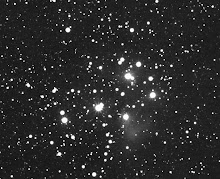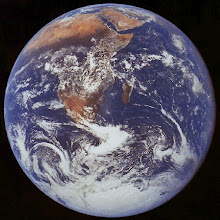Quantum electrodynamics is the eternal direct link between life and the firmament. Secular scientists dislike that word firmament. Yet theologians are more innocent, honest and true to the entirety of the spiritual world in their concern with the firmament, than with any other relationship to society whether religious or no.
The concept of the firmament has changed greatly as modern astronomy and the physics of relativistic motion became confident of the universe in which all existence takes place. Exceedingly distant and myriad exterior galaxies do move, yet their lateral motion is of only minute significance relative to the celestial sphere at such vast distances. Their motion is constrained by energy losses to small fractions of the speed of light, and the speed with which they move never is much greater than a few hundred kilometers each second. These energy losses are measurable in particle accelerators, and the rapid energy loss with increasing speed makes space-time seem viscous like honey or thick oil.
For this reason the map of galaxies has changed very little in all the past three billion years, the fifteen or twenty galactic cycles, since life began on Earth. It will be essentially the same two hundred fifty million years hence as it is today after the Earth and Solar System have traveled around the Milky Way Galaxy yet another time. Exterior galaxies rarely move in visual relationships to each other more than their own diameters in the two hundred twenty million years of a galactic cycle.
Yet quantum electrodynamics is a difficult time for some of those who see intense energy as being the only liberating factor they can stomach. The most obvious manifestations of quantum electrodynamics in life are in the fine details of life. To be sure, they exist both in the most magnificent of life's competition, where the hawk or falcon plummets down at a hundred miles an hour to sieze a pigeon into its claws with instantaneous stunning force, or where a tarpon leaps out of the sea, if there are any tarpon remaining.
More often, quantum electrodynamics is more readily apparent in small, graceful and delicate phenomena such as hovering butterflies or hummingbirds, grazing animals, flowers the colors of which make the very air resonate with fragrance, the sniffing out of dinner by animals with noses dedicated to their own or their family's dinners, and quiet conversations among human beings not constrained to be on bivouac.
Ancient militaries believed in, depended and insisted on, and hoped that life would consist of energetic triumphs over life forever at all times, for it is the teeth and claws, sharp hard parts and the high potential convex surface gradients of small radius, high intensity Paschen curves, the sharp delineation of time into seconds by which energy changes become catastrophic for the inevitable loser. If militaries knew of anything more delicate, they rarely showed that quality. Competition was always which horn clobbered the other horn, or which tooth devoured the meat, or which claw severed which jugular with greater energy, including energy in high valence or nuclear potentials.
Increasing militarization of the world will inevitably make of all the Earth nothing but claws, stingers, fangs, scales and armor. Militaries care as much about the structure, activity, variety and versatility of life as sharks care about clown fish and the beauty and delicacy of sea fans or the thousand other comical, decorated and intricate structures of the oceans and seas. Sharks sacrificed everything interesting about life except speed, noses and sharp teeth to indulge their voracious stomachs. What you insist on is what you get; eventually it is all you get. That happened to ants, and snakes, sharks. probably to the Tasmanian Devil and every other creature that ended up with only a few monstrous characteristics.
It is not an inevitable of the military mind to be forever ignorant of galactic rotation and the right it presents in coordination with ecliptic and equatorial right. That right can be predicted and an advantage. It may be that military concepts of right are concealed in order to prevent other entities from predicting their actions. Yet not to regulate military power carefully is dangerous to a world this small when weapons are so large. For a military to act in response to civil, economic and human rights that are of benefit to life, even where the action is one of enforcement, is no disgrace and it is within strategists to see to it that military effectiveness is not compromised by enemy knowledge of the rights that are among the goals. That makes it easier to impose win-win situations where an opponent refuses to recognize such possibilities of its own free will.
At the present time the slaughter and "harvesting" of wild sentient beings living species as if they are so much dirt, mineral ore. That kind of ruinously aggressive consumption was made possible with the invention of high energy, high power inanimate machines and high energy processing of any and everything organic fed into it into something edible. It is that kind of rapacious unconcerned aggression that has caused world populations of many species to plummet and many species to disappear forever in extinction. The "harvesting" is not as if anyone was cultivating, tilling or herding the creatures; they were simple natural creatures wild and free.
To be sure, it is possible that only the military will be permitted to solve the problems presented by the tragedy of the commons, including the burgeoning overpopulation of the world by human beings who reproduce in impoverished desperate hope for some better life than that which they can give children. Earth risks making an infestation of the human species. Traditional military approaches are not likely to be of much help in alleviating the rape of wildlife, and militaries hate being classified as plural. They are the teeth and scales of zero sum games.
If human legislation does not begin to take careful account of all three celestial planes of rotational asymmetry, in the context of exterior galactic cosmology, no long-term solutions will come to pass at all. The earth's people will leave galactic rotation unresolved, imagining it has nothing to do with them, and wonder at the slow changes since ancient times in the past, as the human species becomes more narrowly constrained to the few things it sees as greatest of its values, and is suaged into abandoning the many interesting, varied and enjoyable amusements of which none constitutes a dominant interest. You get a few things that you want most and nothing else.
In that case Earth will continue to be dominated by Ancients of Days and Ancients of Years, utterly dumb, blind and ignorant about the possibility of an antiquity true in Galactic right.
The National Aeronautics and Space Administration provided, with the Very Large Array, a sufficiently certain, accurate, positive, and deterministic measure of the rate at which the Solar System moves around the Milky Way, often called, and not too inaccurately, Galactic Rotation.
Yet no sign seems to have appeared in any of the world's governments, or its legislative bodies or royal lineages, of any determination of right in terms of Galactic Rotation. Several popular laws absolutely MUST be enacted that can be made world wide, and are sound, certain, determinate and recognizably consistent with not only Constitutional and Universal Human rights, but right as it is known in terms of all these four things
I. The firmament of exterior galaxies;
II. the slow, majestic and historically continuing turning of the Milky Way;
III. the annual, Ecliptic astrological familiar in the calendaring of years;
IV. and the Equatorial daily rotations of the Earth, upon which Universal Human Rights are based.
To be sure, cognoscenti in governments and at the United Nations have since its formation been conscious of exterior galaxies. More is possible. Very large numbers of human beings are quick enough to understand that political, social and other human rights are meaningful not only in the daily rotation demonstrated by the Foucault Pendulum but also the annual motion of the Earth around the Sun, and the geologically slow motion of the entire Solar System with the Earth in tow, around the Milky Way galaxy.
When a piece of legislation that is essentially of positive value and not ridden with pork barrel earmarks comes through which has been graced by specific mention of all three sources of right, cooked perhaps throughout a considerable period of years, or some existing laws that have passed the test of time and can be recognized as consistent with all of those are identified by jurists, then rapid progress is likely to be possible in their light.
Otherwise even going to the Moon again, we are all just going round in circles. And this spinning mote can't do it all.
Monday, June 8, 2009
Wednesday, June 3, 2009
On winding down space exploration and dealing with Earth
Since the telescope was invented, and particularly since rockets and space flight, measurement and gauge of objects apart from Earth has been fast and accurate. It was fast because it was urgent. Understandably, mankind had been concerned about the possible danger to Earth of organisms or even invasion from intelligent species that might inhabit the other planets of the solar system. From ancient time until recently that was a legitimate concern, and so the initial exploration of the solar system was made as quickly, comprehensively and detailed as possible considering the time constraints and formidable technical challenges.
Fortunately, the capability of instruments alone, without manned missions, proved to be far better than had been imagined prior to the development of computers. The result is that the sober and prudently reasonable probability of significant life on any other planet or object in the solar system has been reduced to so close to zero as to make it worth considering as actual zero in the balance of assets and liabilities for the Earth; in the balance of risk and reward; and in the analysis of cost and benefit for deeper concern.
The possibility of micro-organism life has not been ruled out completely, although in the absence of importing such organisms to Earth, that too appears to pose no danger to Earth.
In fact, only a very small number of places in this star system appear to be capable of supporting any life at all, even micro-organisms. This is much smaller number than was thought possible in the 18th century when most of the 1950’s fear or at least serious concern, was raised. The Moon and Mars are likely to be, for a very long time, the only places human beings can actually visit unless manned flights to asteroids or moons of other planets are considered. Mercury and Venus have temperatures forbidding human exploration for centuries, possibly much longer. Phobos and Deimos, the two tiny moons of Mars, are so small and airless they are present essentially no interest. This is also true of every other moon in the solar system except a small number of moons at Jupiter, Saturn, Uranus and possibly Neptune. The great gas planets are of literally nebulous concern. Their ten, thirty, 85 and 165-year orbits have been used for a long time in power struggles between and within nations, and these struggles should be stripped bare of deceit for the entire population of Earth.
The cost of much intense further exploration of the solar system is thus rapidly diminishing in comparison with the value that is certain to be attained on serious large scale consensus of what the existing measures of the solar system actually mean for Earth and its peoples.
As long as concern is raised that further space flights of exploration, adventure, and determination of exotic threat from beyond Earth is worrisome, the result will be to dissuade human beings from drawing proper sober, practical conclusions that are already possible and necessary.
Space flight within the solar system will always be possible, but because of its monstrous cost, it should be carefully evaluated on the basis of its necessity, particularly where other more mundane yet vital necessities exist.
Even Earth-orbit flight is being reviewed more carefully, because the number of objects in earth orbit has become so large as to constitute a junk and litter problem, which arose recently in a collision between two satellites. A more conservative approach is welcome in all aspects of space flight, and though the earth-orbit systems have proved their worth in communications, weather and global positioning services which all have returned the cost of their launch, Earth orbit has become sort of a nonrenewable zone that must be allocated carefully to serve the most vital needs.
A nasty hard line only too easy to encounter in this kind of reasoning, is the problem that while the population of human beings already strains the planet and is estimated by some to be beyond the planet’s carrying capacity, some populations are in conditions of famine, plague and violence. This contrast makes Schadenfreude almost unavoidable, and in this context glaukenstucken is almost unavoidable as well.
Yet the simple truth is that procreation is quite capable of going far beyond reason. Examples of plague and infestation are legion, including locusts, frogs, bubonic plague, smallpox and others by the hundreds. Human beings do not want to make of themselves a pestilence on or in a planet which they understand. This is the terrible contradiction of the times.
In other words, while correct conclusions are already possible regarding the solar system, solutions to the problems Earth already faces are not yet attainable without great cost and determined undertaking. More struggles to determine more about the solar system in the vanishing hope of finding significant life on other celestial bodies, and struggles to find other problems from space, are only diverting attention away from serious problems already existing and well known here on Earth. Determination to spend huge sums on space flight at this time can be called a symptom of escapism.
Because of the intensity of Earth’s problems such as population pressures, destruction of Earth’s wild living species with the attendant killing of sentient beings, and other development factors such as the proper long-term evolution of cities, architecture, and human systems, conclusions of this sort are vital.
They should be drawn up among international consultants, probably in cooperation with other responsible organizations, and with the guidance of persons expert in the better doctrines of knowledge available today. This is not, of course, a place where casual reckoning will suffice even though many of the most carefully reasoned conclusions are likely to be common-sense. They will in that case be ever so much more gladly welcomed by the world’s people, and they should be surprising to few.
Good and honest conclusions should be drawn about which factors beyond Earth are likely to remain unchanged for long periods of time, such as millions of years, and which are capable of posing any new situations for Earth. For instance, every sign exists that the Moon and Mars will be essentially unchanging throughout the next two hundred fifty million year Galactic cycle; that the same is true for all the other airless bodies in stable orbits; and that even other bodies such as Jupiter and Saturn, which have thick atmospheres, are not likely to present disruptive events in the foreseeable future, possibly on the galactic time scale as well. In any case, such future events of that kind as exist are not predictable and it will be possible to address them only when they occur.
Much valuable work already exists, on the other hand, regarding those factors in the solar system which, usually because of orbital paths, might pose problems to Earth. The main ones are the Near Earth Objects, for asteroids large and small pose measurable dangers from collisions with Earth. Meteor crater in Arizona is a good example. Development of programs to catalog such objects and determine the danger they present is already well under way, needs continued funding but not seriously strange new paths of research, and is important.
In other words, the accurate determination of what Earth needs to know is already either complete in preliminary yet assuring status, or is ongoing. But it is confused with a great deal of hype, jingoism, speculation, exploitation, graft, boondoggling, advertising, and venture capitalism that is often in not only relentless pursuit of profits, but is callous in its approach to the cultivation of Earth as the only planet that will positively present a sanctuary for life for a long, long time. Principles which conceivably might permit flight to the stars continue to exist only in the imagination, and could be cosmologically forbidding for many generations – possibly many thousands of years, or more. Already it is known that even with fusion powered ion or photon rockets, the mass ratio of a vehicle capable of reaching even the nearest star is extremely far beyond technological feasibility. Whatever science might permit flight to other star systems is not even conceivable yet.
Like a band of travelers finding themselves on a small but habitable island, which walks around it three or four times and swims to a half dozen rocks lying offshore, yet remains reluctant to admit it is where it is for years. Eventually it begins to find that time has passed; its member remain alive and the convincing fact is that they are surviving and more, even managing to make themselves comfortable at the slight cost of discarding much of what they thought were essentials of civilization. Soon they realize they have become much like islanders everywhere since the dawn of time, and will live. Presuming of course only that they are a mixed company.
So it is to be expected that in the light of correct assessment of the situation Earth faces in the solar system and truly expected future, there is to be a general devolution of civilization to some extent. Just what this means is not clear, nor is it clear that the best course will be obvious without a good deal of presentation of the problem to the world or at least to the American public. Yet the world is in desperate need of the best possible determination. What it needs is for good problem-solvers to step forth and speak to the issue. This will include political leaders of experience, honesty, good faith and sound judgment, as well as the testimonies of persons who have been in space.
Fortunately, the latter includes persons of widely diverse range expertise and viewpoint. The dialogue should be international. Even if some player nations insist on maintaining theirs is the only solution, they should take opinions from all the world into account. The primary points of the resulting “planetary doctrine” should be a relatively small number of salient facts, with an emphasis on dealing, in the light of those facts, with several major and intense problems which are already well known.
Known problems probably span the field of all Earth’s eventual problems fairly well. In other words, while problems are certain to arise, they are not often to be of an unusual kind.
Examples of known kinds of problems include weather, earthquakes, volcanoes, tsunami, violence, economic instability, disease and plague, accident, economic inequality, over population, destruction of the habitat of Earth, the killing of sentient creatures, pollution and others.
Assets should be assessed candidly and realistically as well. This is not unlike the small island scenario. Assets include ancient and traditional technology, some of which already is or may be increasingly returned to prevalent use; new technology, some of which may be kept and developed, others of which may be abandoned; and future technology, of which development should be significantly sustained on the basis of existing need for it.
The existing consciousness of Earth suffers only from too much complexity and an unwillingness to distil the menagerie of ideas toward a comprehensive statement of fact that is not too much a bourgeoning plethora of opinions and represents the essential necessary and sufficient facts that will be considered equally important a hundred or thousand years from now. All the good ideas seem to be flowing already among a vast flood of information from which they are difficult to extract.
Fortunately, the capability of instruments alone, without manned missions, proved to be far better than had been imagined prior to the development of computers. The result is that the sober and prudently reasonable probability of significant life on any other planet or object in the solar system has been reduced to so close to zero as to make it worth considering as actual zero in the balance of assets and liabilities for the Earth; in the balance of risk and reward; and in the analysis of cost and benefit for deeper concern.
The possibility of micro-organism life has not been ruled out completely, although in the absence of importing such organisms to Earth, that too appears to pose no danger to Earth.
In fact, only a very small number of places in this star system appear to be capable of supporting any life at all, even micro-organisms. This is much smaller number than was thought possible in the 18th century when most of the 1950’s fear or at least serious concern, was raised. The Moon and Mars are likely to be, for a very long time, the only places human beings can actually visit unless manned flights to asteroids or moons of other planets are considered. Mercury and Venus have temperatures forbidding human exploration for centuries, possibly much longer. Phobos and Deimos, the two tiny moons of Mars, are so small and airless they are present essentially no interest. This is also true of every other moon in the solar system except a small number of moons at Jupiter, Saturn, Uranus and possibly Neptune. The great gas planets are of literally nebulous concern. Their ten, thirty, 85 and 165-year orbits have been used for a long time in power struggles between and within nations, and these struggles should be stripped bare of deceit for the entire population of Earth.
The cost of much intense further exploration of the solar system is thus rapidly diminishing in comparison with the value that is certain to be attained on serious large scale consensus of what the existing measures of the solar system actually mean for Earth and its peoples.
As long as concern is raised that further space flights of exploration, adventure, and determination of exotic threat from beyond Earth is worrisome, the result will be to dissuade human beings from drawing proper sober, practical conclusions that are already possible and necessary.
Space flight within the solar system will always be possible, but because of its monstrous cost, it should be carefully evaluated on the basis of its necessity, particularly where other more mundane yet vital necessities exist.
Even Earth-orbit flight is being reviewed more carefully, because the number of objects in earth orbit has become so large as to constitute a junk and litter problem, which arose recently in a collision between two satellites. A more conservative approach is welcome in all aspects of space flight, and though the earth-orbit systems have proved their worth in communications, weather and global positioning services which all have returned the cost of their launch, Earth orbit has become sort of a nonrenewable zone that must be allocated carefully to serve the most vital needs.
A nasty hard line only too easy to encounter in this kind of reasoning, is the problem that while the population of human beings already strains the planet and is estimated by some to be beyond the planet’s carrying capacity, some populations are in conditions of famine, plague and violence. This contrast makes Schadenfreude almost unavoidable, and in this context glaukenstucken is almost unavoidable as well.
Yet the simple truth is that procreation is quite capable of going far beyond reason. Examples of plague and infestation are legion, including locusts, frogs, bubonic plague, smallpox and others by the hundreds. Human beings do not want to make of themselves a pestilence on or in a planet which they understand. This is the terrible contradiction of the times.
In other words, while correct conclusions are already possible regarding the solar system, solutions to the problems Earth already faces are not yet attainable without great cost and determined undertaking. More struggles to determine more about the solar system in the vanishing hope of finding significant life on other celestial bodies, and struggles to find other problems from space, are only diverting attention away from serious problems already existing and well known here on Earth. Determination to spend huge sums on space flight at this time can be called a symptom of escapism.
Because of the intensity of Earth’s problems such as population pressures, destruction of Earth’s wild living species with the attendant killing of sentient beings, and other development factors such as the proper long-term evolution of cities, architecture, and human systems, conclusions of this sort are vital.
They should be drawn up among international consultants, probably in cooperation with other responsible organizations, and with the guidance of persons expert in the better doctrines of knowledge available today. This is not, of course, a place where casual reckoning will suffice even though many of the most carefully reasoned conclusions are likely to be common-sense. They will in that case be ever so much more gladly welcomed by the world’s people, and they should be surprising to few.
Good and honest conclusions should be drawn about which factors beyond Earth are likely to remain unchanged for long periods of time, such as millions of years, and which are capable of posing any new situations for Earth. For instance, every sign exists that the Moon and Mars will be essentially unchanging throughout the next two hundred fifty million year Galactic cycle; that the same is true for all the other airless bodies in stable orbits; and that even other bodies such as Jupiter and Saturn, which have thick atmospheres, are not likely to present disruptive events in the foreseeable future, possibly on the galactic time scale as well. In any case, such future events of that kind as exist are not predictable and it will be possible to address them only when they occur.
Much valuable work already exists, on the other hand, regarding those factors in the solar system which, usually because of orbital paths, might pose problems to Earth. The main ones are the Near Earth Objects, for asteroids large and small pose measurable dangers from collisions with Earth. Meteor crater in Arizona is a good example. Development of programs to catalog such objects and determine the danger they present is already well under way, needs continued funding but not seriously strange new paths of research, and is important.
In other words, the accurate determination of what Earth needs to know is already either complete in preliminary yet assuring status, or is ongoing. But it is confused with a great deal of hype, jingoism, speculation, exploitation, graft, boondoggling, advertising, and venture capitalism that is often in not only relentless pursuit of profits, but is callous in its approach to the cultivation of Earth as the only planet that will positively present a sanctuary for life for a long, long time. Principles which conceivably might permit flight to the stars continue to exist only in the imagination, and could be cosmologically forbidding for many generations – possibly many thousands of years, or more. Already it is known that even with fusion powered ion or photon rockets, the mass ratio of a vehicle capable of reaching even the nearest star is extremely far beyond technological feasibility. Whatever science might permit flight to other star systems is not even conceivable yet.
Like a band of travelers finding themselves on a small but habitable island, which walks around it three or four times and swims to a half dozen rocks lying offshore, yet remains reluctant to admit it is where it is for years. Eventually it begins to find that time has passed; its member remain alive and the convincing fact is that they are surviving and more, even managing to make themselves comfortable at the slight cost of discarding much of what they thought were essentials of civilization. Soon they realize they have become much like islanders everywhere since the dawn of time, and will live. Presuming of course only that they are a mixed company.
So it is to be expected that in the light of correct assessment of the situation Earth faces in the solar system and truly expected future, there is to be a general devolution of civilization to some extent. Just what this means is not clear, nor is it clear that the best course will be obvious without a good deal of presentation of the problem to the world or at least to the American public. Yet the world is in desperate need of the best possible determination. What it needs is for good problem-solvers to step forth and speak to the issue. This will include political leaders of experience, honesty, good faith and sound judgment, as well as the testimonies of persons who have been in space.
Fortunately, the latter includes persons of widely diverse range expertise and viewpoint. The dialogue should be international. Even if some player nations insist on maintaining theirs is the only solution, they should take opinions from all the world into account. The primary points of the resulting “planetary doctrine” should be a relatively small number of salient facts, with an emphasis on dealing, in the light of those facts, with several major and intense problems which are already well known.
Known problems probably span the field of all Earth’s eventual problems fairly well. In other words, while problems are certain to arise, they are not often to be of an unusual kind.
Examples of known kinds of problems include weather, earthquakes, volcanoes, tsunami, violence, economic instability, disease and plague, accident, economic inequality, over population, destruction of the habitat of Earth, the killing of sentient creatures, pollution and others.
Assets should be assessed candidly and realistically as well. This is not unlike the small island scenario. Assets include ancient and traditional technology, some of which already is or may be increasingly returned to prevalent use; new technology, some of which may be kept and developed, others of which may be abandoned; and future technology, of which development should be significantly sustained on the basis of existing need for it.
The existing consciousness of Earth suffers only from too much complexity and an unwillingness to distil the menagerie of ideas toward a comprehensive statement of fact that is not too much a bourgeoning plethora of opinions and represents the essential necessary and sufficient facts that will be considered equally important a hundred or thousand years from now. All the good ideas seem to be flowing already among a vast flood of information from which they are difficult to extract.
Subscribe to:
Posts (Atom)







